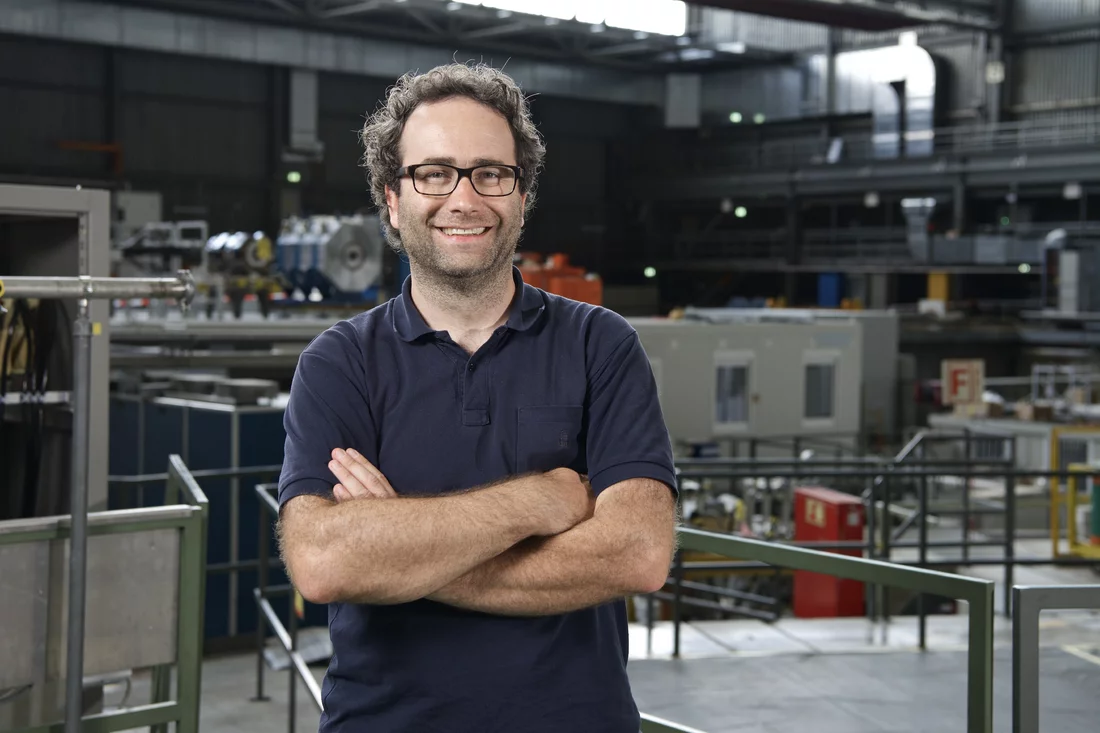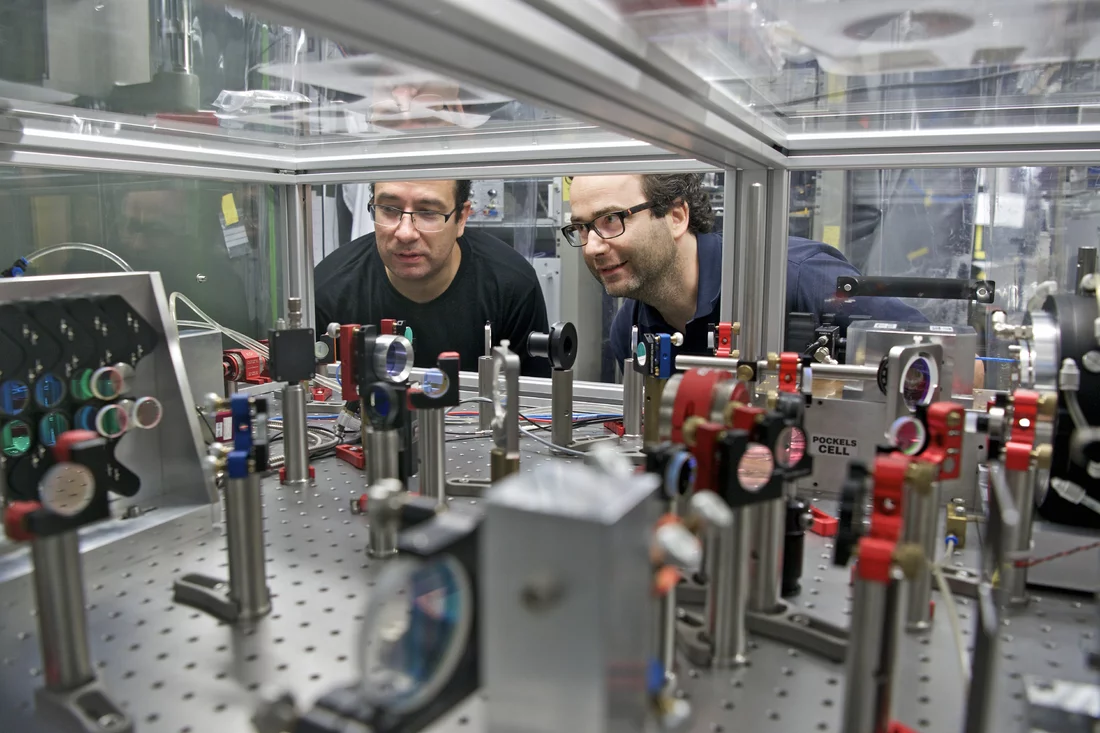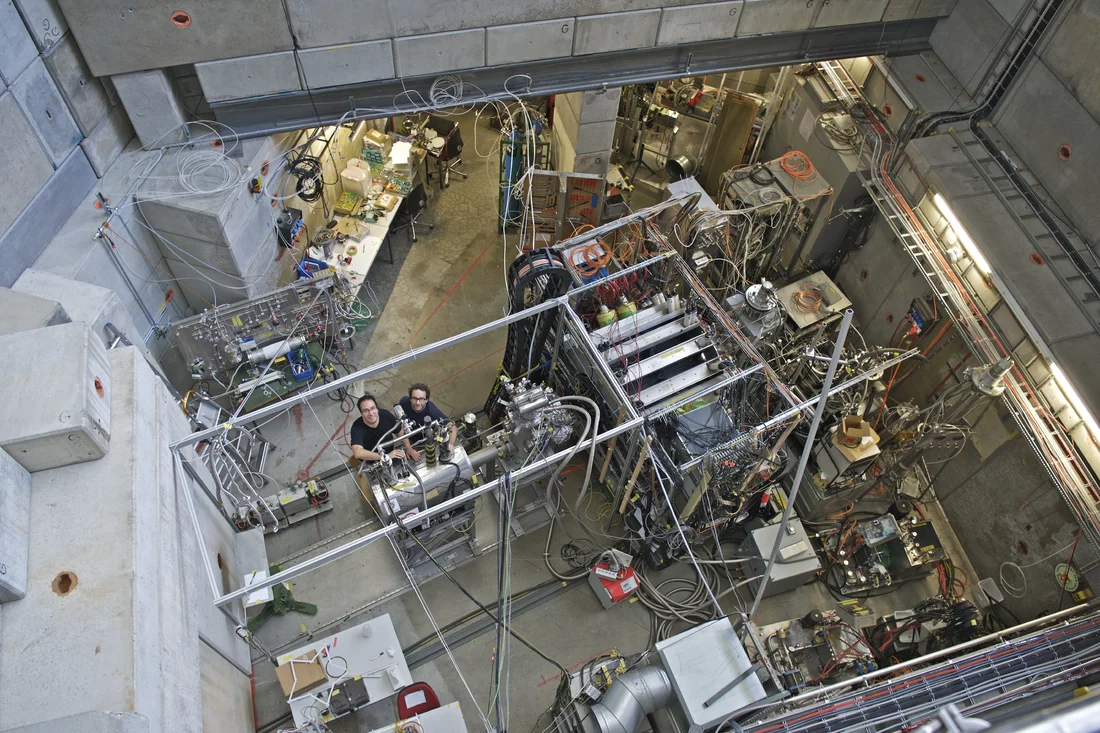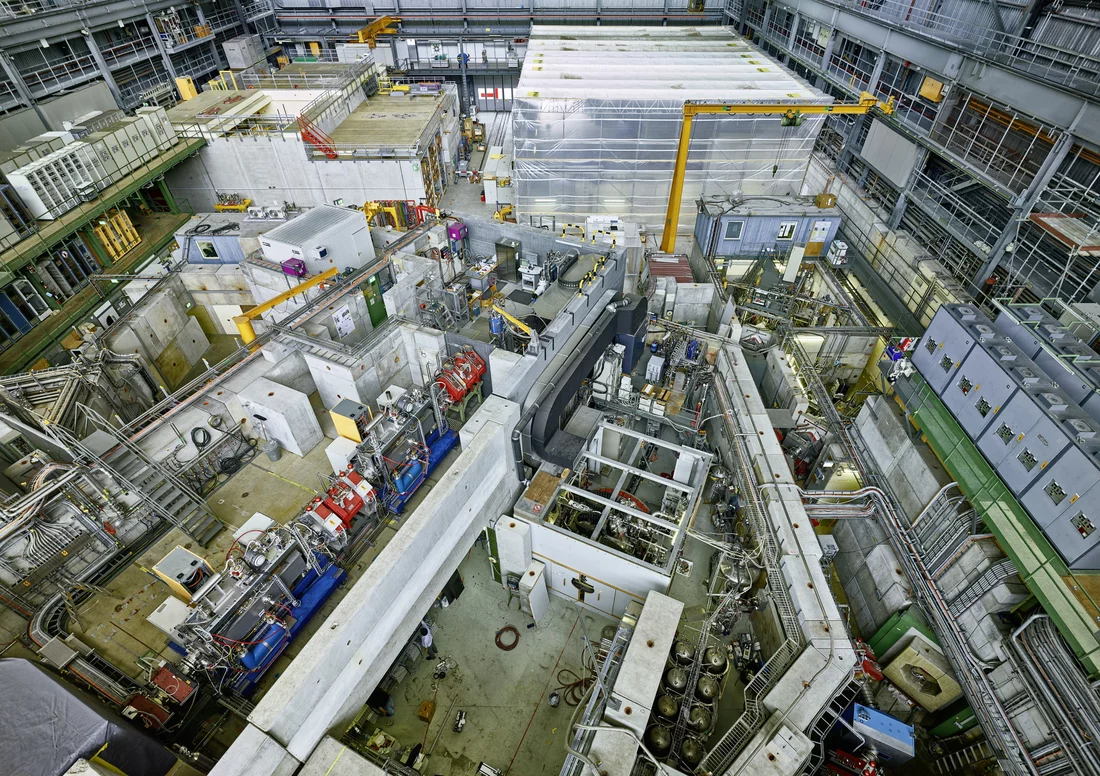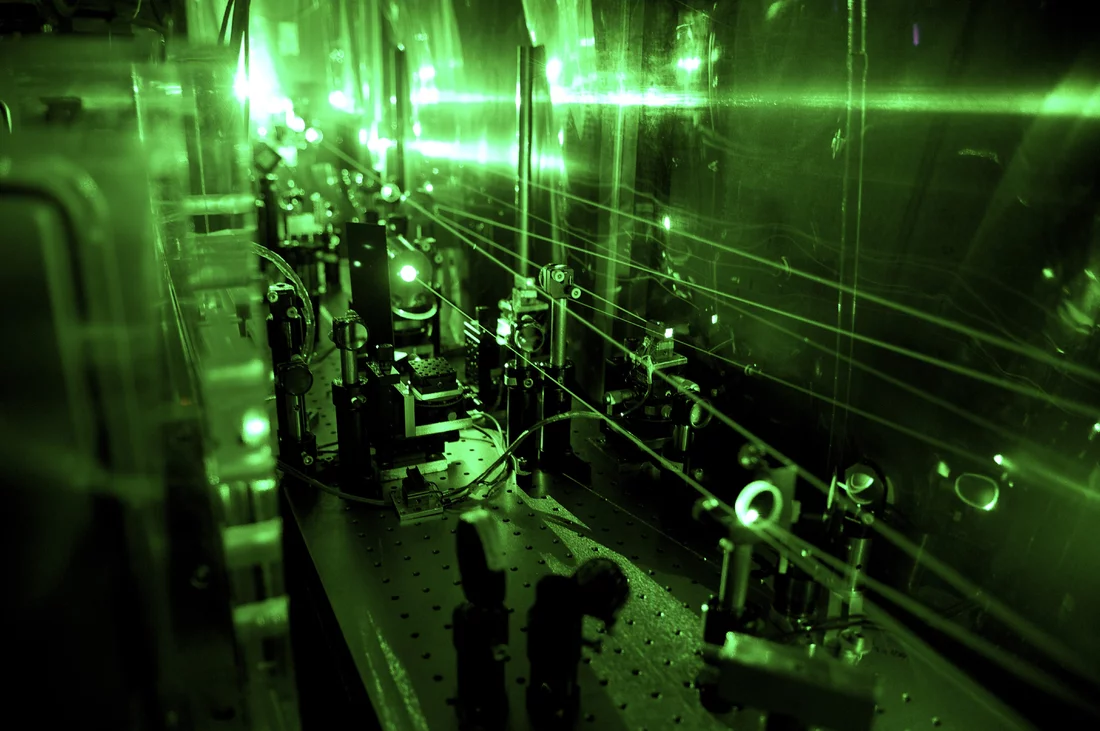The deuteron — just like the proton — is smaller than previously thought
The deuteron — one of the simplest atomic nuclei, consisting of just one proton and one neutron — is considerably smaller than previously thought. This finding was arrived at by an international research group that carried out experiments at the Paul Scherrer Institute, PSI. The new result is consistent with a 2010 study by the same group, in which the researchers measured the proton and found a significantly smaller value than previous research using different experimental methods. The result from 2010 formed the basis for what has been known since then as the proton radius puzzle. The new measurement of the deuteron’s size has now given rise to an analogous mystery. It is possible that this will lead to an adjustment of the Rydberg constant, a fundamental quantity in physics. Another possible explanation is that a physical force as yet unknown is at work. For their experiments the researchers used laser spectroscopy to measure so-called muonic deuterium: an artificial atom consisting of a deuteron orbited by an exotic elementary particle known as a muon. The experiments took place at PSI because the world’s most powerful muon source, available here, was needed to produce sufficient muonic deuterium. The researchers have published their new study of the deuteron’s size in the renowned journal Science.
The deuteron is smaller than previous measurements have found. A deuteron is a very simple atomic nucleus made up of just one proton and one neutron — that is, one each of the two nuclear building blocks. An international research collaboration, working at the Paul Scherrer Institute PSI, has measured the deuteron more accurately than ever before. The value they obtained for the radius of the deuteron does not, however, correspond to the measurements of other research groups but instead shows a significantly smaller value.
In spite of this contradiction, there is also an agreement: In 2010 the same research group reported on the measurement of individual protons by means of the same method. Then, as well, the measurement clearly showed that the proton is smaller than had been thought to date. Since then, the research community has referred to this situation as the proton radius puzzle.
A further analysis of proton data from PSI confirmed the same small value in 2013.
So now it’s the deuteron, too. No one in the community believes any more that our method, the laser spectroscopy, might be flawed,
PSI physicist Aldo Antognini asserts. And his research partner Randolf Pohl, who now works at the University of Mainz, adds: After our first study came out in 2010, I was afraid some veteran physicist would get in touch with us and point out our great blunder. But the years have passed, and so far nothing of the kind has happened.
And now the new study — the measurement of the deuteron — also confirms the mystery of the proton radius. You could say that the mystery has now doubly confirmed itself,
Pohl concludes.
Along with scientists at PSI, collaborators at ETH Zurich and the Max Planck Institute of Quantum Optics (Germany), as well as researchers in Paris (France), Coimbra (Portugal), Stuttgart (Germany), Freiburg (Switzerland), and Hsinchu (Taiwan) also had significant involvement in the study.
New experiment creates excitement
The new research result is actually more than a doubling of the old mystery of the proton radius: Beyond that, it can further the search for the true nature of things. Naturally it can’t be that the deuteron — any more than the proton — has two different sizes,
says Antognini. Thus the scientific community is searching for explanations that can bring the different values back into harmony.
One possible explanation is that a physical force as yet unknown is at work. For the scientists, that is an exciting scenario; it is, however, highly improbable.
A more obvious explanation would be experimental imprecision. Actually, the mystery could be solved very easily if we assume a minimal experimental problem with the hydrogen spectroscopy,
Antognini explains. Some of the earlier measurements, of both the proton’s size and the deuteron’s size, were based on this method.
Another method for determining the sizes of the proton and the deuteron uses electron scattering. The deuteron size that was measured via electron scattering is in fact compatible with the new value obtained by the PSI research group, but there is comparatively large uncertainty about its overall accuracy.
To crack the riddle of the proton radius, several research groups who use hydrogen spectroscopy or electron scattering began, some years ago, to upgrade their experiments and improve their precision. Antognini and Pohl are proud of that: If our value had agreed with the previous ones, there would not have been this darned mystery of the proton radius; but there also never would have been this worldwide surge of activity that has led to several highly accurate measurement setups,
Pohl says. Currently research groups in Munich, Paris, and Toronto are working to obtain more accurate measurements via hydrogen spectroscopy. Their results are expected in the coming years.
Physical constants might need to be adjusted
If it should actually turn out that the hydrogen spectroscopy is giving a false — that is, minimally shifted — value, that would mean that the Rydberg constant must be minimally changed,
Antognini explains. The Rydberg constant and the proton radius are two physical quantities that are strongly coupled to each other. To date, among all physical constants, the Rydberg constant is the one that has been determined with the highest precision: Even its eleventh decimal place is already known. Still, thanks to the mystery of the proton radius, this last decimal place could still change a bit. That would have consequences for many areas of physics and would lead to minimal corrections for other constants of nature.
It took world’s most powerful muon source
To determine the size of the deuteron at PSI, the researchers first produced artificial atoms: muonic deuterium. These atoms have a nucleus of one deuteron, which is orbited by one muon.
The muon source of PSI is the most high-performance system of its kind in the world. Thanks to this, it was possible to inject around 300 muons per second into the experiment chamber. There they hit atoms of gaseous deuterium, flung their electrons out, and took their place. The result was atoms of muonic deuterium.
Muons are negatively charged elementary particles that strongly resemble electrons but are around 200 times heavier. Because of their higher mass, the muons move much closer to the atomic nucleus, and the properties of their orbits depend much more strongly on the size of this nucleus.
The researchers exploited this: With a highly complex pulsed laser system developed specifically for this experiment, they excited the muon in the artificial atom. The wavelength of the laser can be varied in steps. At exactly the right wavelength, the muon was raised from one energetic state to another; from there it immediately fell back to a lower state, sending out one X-ray photon in the process. Those wavelengths of laser light at which the maximum number of X-ray photons were generated marked the energetic state of the respective muon orbits around the nucleus. This energetic state depends strongly on the radius of the deuteron: Thus, by means of their measurement curve, the researchers were able to determine the size of the deuteron. This is quite similar to the way they measured the proton’s size in their 2010 study.
Text: Paul Scherrer Institute/Laura Hennemann
Atoms and muons
Every object, every living thing, every planet, and every star in the universe is made up of atoms. At the center of every atom is its nucleus, consisting of protons and neutrons that are held together by the nuclear strong force. At relatively large distances from the nucleus, the considerably smaller electrons orbit around it.The simplest atom is that of hydrogen: It consists of just one proton, which alone and without any neutron forms the nucleus, and one electron. With one additional neutron in the nucleus, the atom becomes deuterium; its nucleus, thus made up of one neutron and one proton, is called the deuteron. A bit more substantial still is the helium atom, consisting of two protons, one or two neutrons, and two electrons orbiting around this nucleus. By mentally adding ever more nuclear particles and electrons in turn, you can come up with all the elements of the periodic table.
Muons are also elementary particles, but they are not part of usual atoms. Muons are very short-lived — they decay into other particles just a few millionths of a second after they come into existence. Experiments with muons must therefore run with corresponding speed. At the most powerful muon source worldwide — at PSI — there are several measurement stations at which such experiments can be carried out.
About PSI
The Paul Scherrer Institute PSI develops, builds and operates large, complex research facilities and makes them available to the national and international research community. The institute's own key research priorities are in the fields of matter and materials, energy and environment and human health. PSI is committed to the training of future generations. Therefore about one quarter of our staff are post-docs, post-graduates or apprentices. Altogether PSI employs 2000 people, thus being the largest research institute in Switzerland. The annual budget amounts to approximately CHF 370 million. PSI is part of the ETH Domain, with the other members being the two Swiss Federal Institutes of Technology, ETH Zurich and EPFL Lausanne, as well as Eawag (Swiss Federal Institute of Aquatic Science and Technology), Empa (Swiss Federal Laboratories for Materials Science and Technology) and WSL (Swiss Federal Institute for Forest, Snow and Landscape Research).
(Last updated in May 2016)
Additional information
Protons – smaller than we thought– Text from 8 July 2010 on proton measurements at PSI
Proton size puzzle reinforced!– Text from 25 January 2013 on proton measurements at PSI
Contact
Dr. Aldo Antognini, Research group for muon physics, Laboratory for particle physics,Paul Scherrer Institute, 5232 Villigen PSI, Switzerland, and Department of Physics, ETH Zurich, 8093 Zurich, Switzerland
Telephone: +41 56 310 46 14, e-mail: aldo.antognini@psi.ch [German, English, Italian]
Dr. Randolf Pohl, Max Planck Institute of Quantum Optics, 85748 Garching, Germany, and Johannes Gutenberg University Mainz, 55099 Mainz, Germany
Telephone: +49 17 14 17 07 52, e-mail: randolf.pohl@mpq.mpg.de [German, English]
Original Publication
Laser spectroscopy of muonic deuteriumR. Pohl, F. Nez, L.M.P. Fernandes, F.D. Amaro, F. Biraben, J.M.R. Cardoso, D.S. Covita,
A. Dax, S. Dhawan, M.Diepold, A. Giesen, A.L. Gouvea, T. Graf, T.W. Hänsch, P. Indelicato,
L. Julien, P. Knowles, F. Kottmann, E.-O. Le Bigot, Y.-W. Liu, J.A.M. Lopes, L. Ludhova,
C.M.B. Monteiro, F. Mulhauser, T. Nebel, P. Rabinowitz, J.M.F. dos Santos,
L.A. Schaller, K. Schuhmann, C. Schwob, D. Taqqu, J.F.C.A. Veloso, A. Antognini
Science 12 August 2016: Vol. 353, no. 6300, page 669
DOI: 10.1126/science.aaf2468

